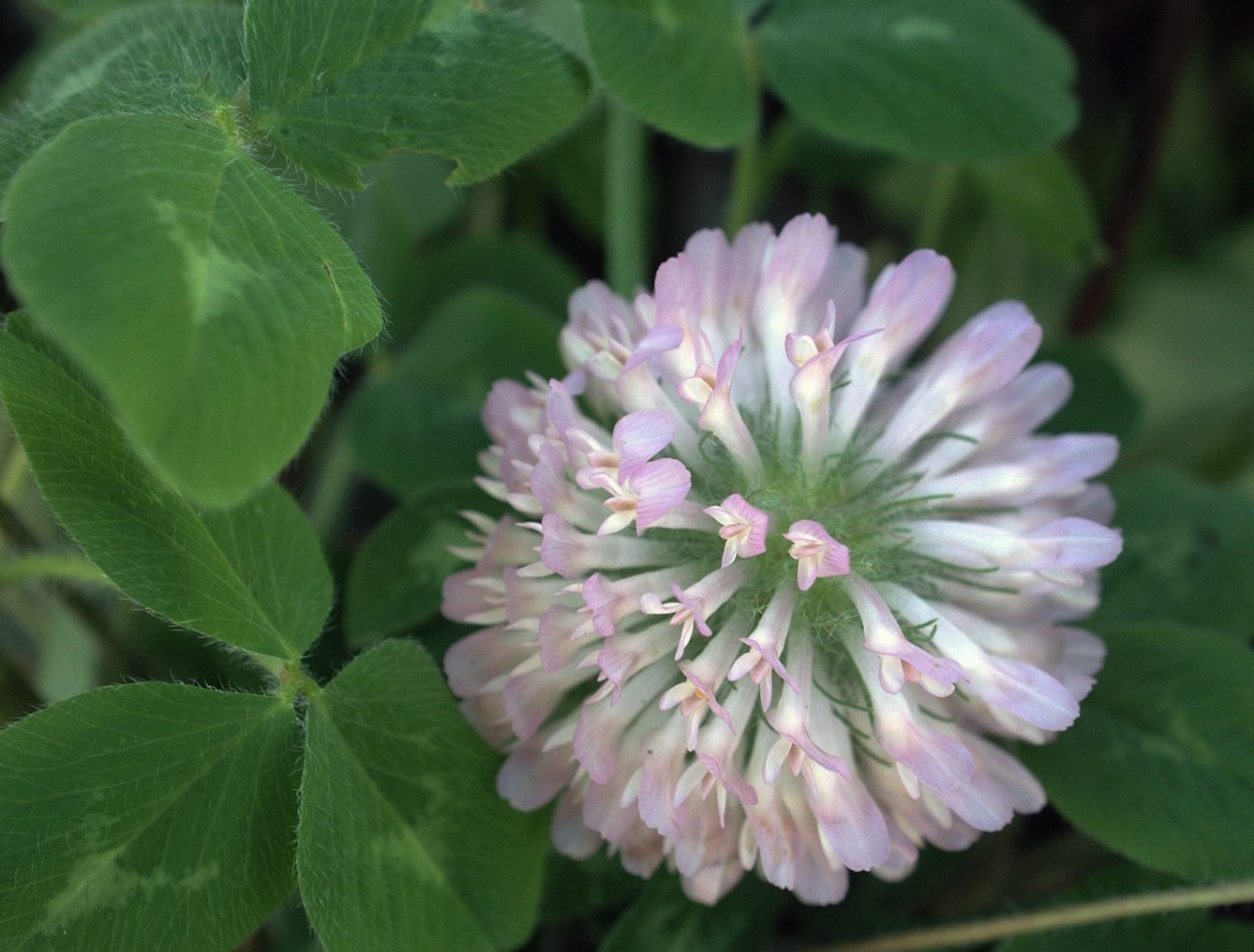
by Matt Lollar | Mar 5, 2019
Many gardeners plant a spring vegetable garden with a number of different vegetable types, which is excellent because a diverse and varied garden is proven to improve soil health. Intercropping is a gardening practice of growing different crops in the same field. When planting a mixture of crops in the same field year after year, it is important to rotate the location of each type of vegetable. This is a practice known as crop rotation. Intercropping and crop rotation will help reduce insect pest populations, increase beneficial insect populations, and reduce weed populations .
Crop Diversity
Including plants that pest insects don’t like to eat in a garden forces the pests work harder to find what they find palatable. Studies have found reduced whitefly numbers on squash plantings mixed with a crop of buckwheat when compared to squash planted alone. Another crop mixture that may be unintentional, but may be favorable, is a crapemyrtle stand along a garden’s edge. Crapemyrtles will attract the crapemyrtle aphid which will attract predatory insects. When the predatory insects run out of crapemyrtle aphids to eat, they will move to the vegetable garden and begin to hunt pest insects.

Squash with living mulch of buckwheat. Photo Credit: Oscar Liburd, UF/IFAS Extension
Trap Cropping
A trap crop is a plant that attracts a pest insect away from your food crops. Trap crops work best when planted at the garden’s edge, along a fence row, or in movable containers. A bare space, let’s say 5 feet or so, should be kept between trap crops and vegetable plantings. This will help keep the pests from moving desirable crops plants. When a large population of pests are found on the trap crop then it is time to spray them with insecticide, or cut the crop down and remove or destroy the debris. If trap crops are planted in containers, then it makes them much easier to remove from the garden when necessary.
Cover Crops and Green Manure
Soil organic matter can be increased by the use of green manure and cover crops. Cover crops are generally planted during the off-season, but they can be planted in between vegetable rows and tilled in at a designated time as a green manure. Both cover crops and green manure improve garden production by:
- Suppressing weeds by competing for water, light, and nutrients;
- Holding the soil in place and preventing erosion;
- Scavenging for nutrients that can be utilized in future crops;
- Reducing nematode populations;
- Providing a habitat for beneficial insects.

A mixed plot of cover crops and trap crops. Photo Credit: Matt Lollar, UF/IFAS Extension – Santa Rosa County
A number of different crops can serve as cover crops or green manure crops. Most are legumes (bean family) or grasses. A few that should be tried are:
- Cowpeas
- Sunn hemp
- Sorghum-sudangrass
- Winter rye
More detailed information on cover crops and green manure can be found at this link: http://edis.ifas.ufl.edu/aa217.

by Julie McConnell | Jan 3, 2019
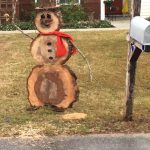
Storm debris turned into holiday cheer in Bayou George. Photo: J_McConnell, UF/IFAS
By the time this article publishes, we will be more than 70 days since Hurricane Michael toppled or damaged an incredible number of trees in the Panhandle. Enormous piles of once stately shade trees line the streets in neighborhoods and business districts in. The cleanup efforts have been phenomenal, over 4 million cubic yards of storm debris picked up in Bay County to date, but there is still a long way to go in the recovery process.
So, as gardeners, how can you help our community get back on track amidst your own struggles to recover? A few Florida Friendly Landscaping™ Principles come to mind.
- #1 Right Plant, Right Place – as you rebuild your landscapes, make sure to choose the appropriate plant for the location. Consider mature size and give those plants space to thrive!
- #4 Mulch – do you have bare ground that will eventually become landscape beds or turf but no resources or time to replant yet? Consider mulching the area to keep soil from eroding and to help improve soil though decomposition of natural products. Hint – see Recycling for free sources!
- Mulch tips https://sfyl.ifas.ufl.edu/media/MulchBrochure.pdf
- keep mulch 12 inches from tree trunks
- recommended depth in beds or under dripline of tree canopy (excluding within 12” of trunk) is 2-3 inches
- leave an 18-24 inch buffer around building foundations mulch free to reduce conducive termite conditions
-
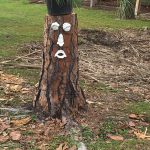
Dress up stumps with plants and whimsical designs. Photo: D_VanderMeer, UF/IFAS Master Gardener
#7 Recycle – driving around town I have seen some really creative uses for stumps, trunks, and branches that homeowners have constructed and messages of hope that bring a smile to my face. Another method of recycling is to use the chipped vegetative debris as mulch, either available as “utility mulch” by cities and counties or you may have some in your own yard right now.
- Utility mulch does come with some words of caution because there is an increased risk of introducing weeds to your landscape with untreated storm debris. However, if you need mulch for pathways or planting beds you will be helping your community’s cleanup effort by reducing waste accumulation. Just watch for “volunteer” plants and manage as needed.
In Bay County, there are 4 locations where you can load and haul off your own utility mulch from storm debris
- Under the Oaks Park – 5843 E. U.S. 98, Panama City, FL 32404
- G. Harder’s Park – 8110 John Pitts Rd., Panama City, FL 32401
- Chapman Park – 2526 Rollins Ave., Bayou George, FL 32404
- Laird Park – 6310 Laird Park Rd., Panama City, FL 3240
For sources in your county, check with your Solid Waste Department for utility mulch availability.
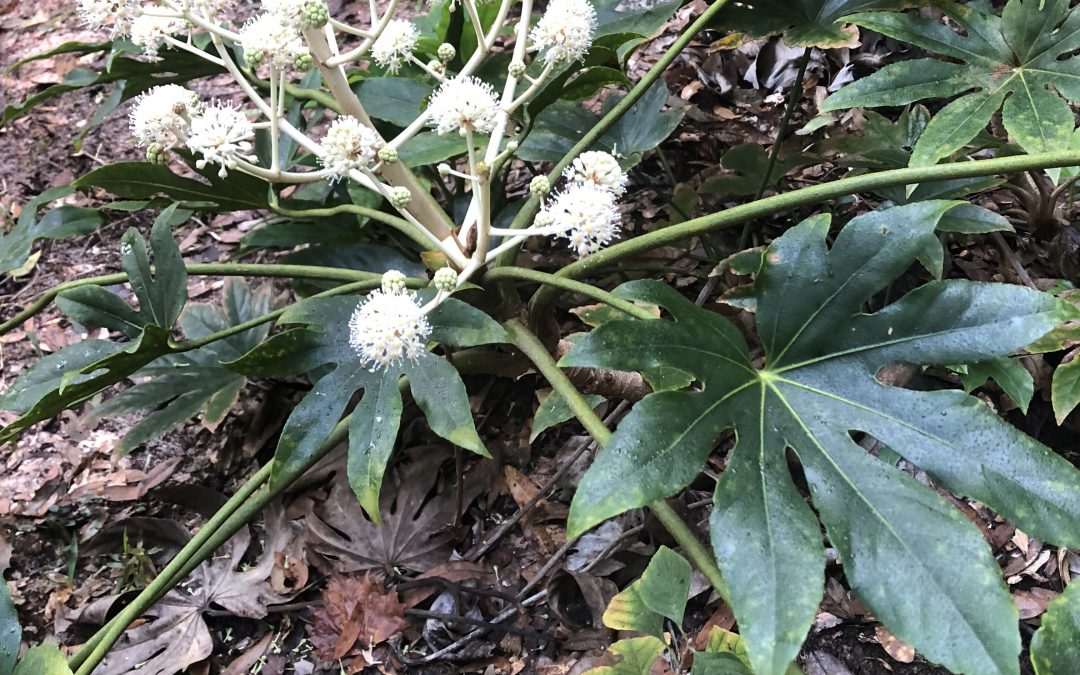
by Matt Lollar | Dec 17, 2018
Fatsia japonica, common name Japanese aralia, provides tropical texture to your landscape. That coarse texture is attributed to its large (nearly a foot wide) leaves that are deeply lobed (maple leaf shaped). This shade-loving plant performs well in moist (not soggy) locations. Upright stems originate near ground level usually near the base of older stems. The stems grow to about eight feet tall before bending toward the ground under their own weight.
Even though the foliage of this species is enough to make you want it in your own garden, you will absolutely fall in love with its blooms. Upright clusters of showy, creamy white flowers begin to appear in fall. These little snowballs provide wonderful color to your garden. The shiny, black fruits appear in winter and are prominent for several weeks. The fruit are know to attract birds to the landscape.
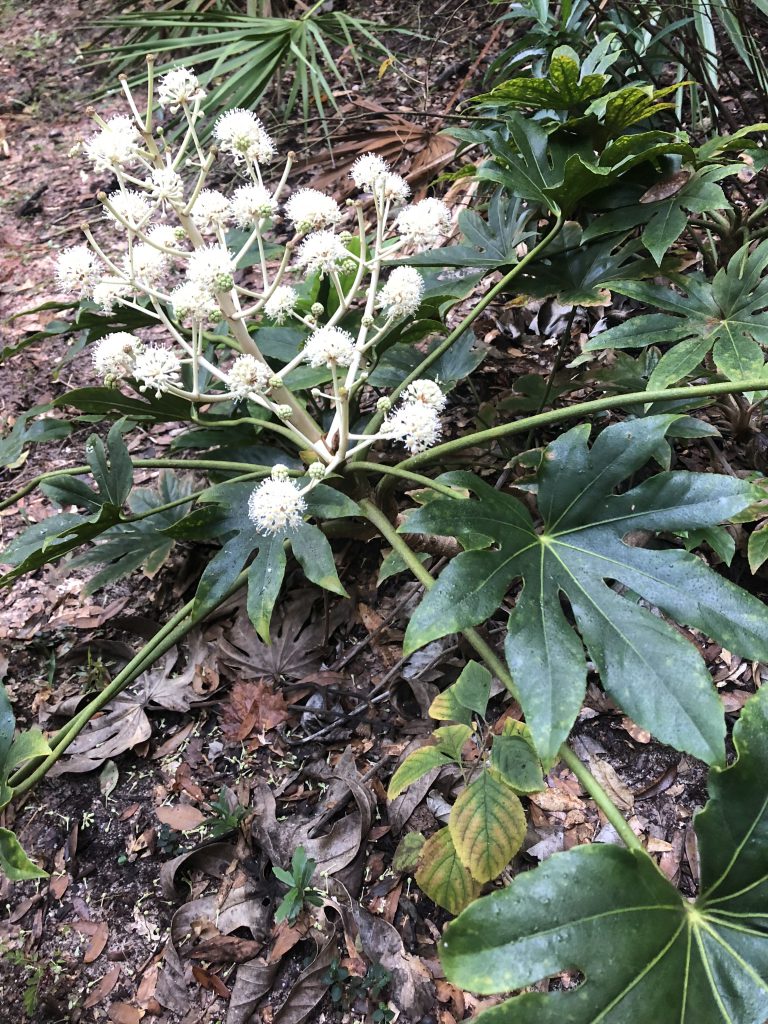
A Fatsia japonica specimen in full bloom. Photo Credit: Matt Lollar, University of Florida/IFAS Extension
Fatsia japonica thrives in the shade in slightly acidic, nutrient-rich, moist soil. Older stems become leggy and can be cut back to encourage branching. In the right place, Fatsia japonica is low-maintenance and not typically bothered by pests. It is also known to perform well in coastal landscapes. It fits well in entryways, in containers, or in mass plantings spaced three feet apart.
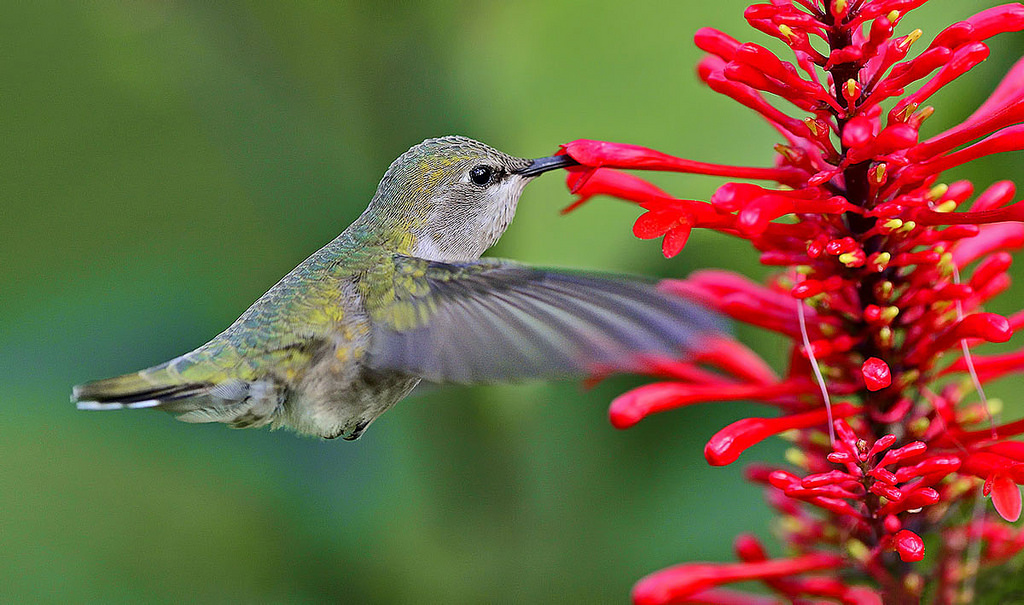
by Sheila Dunning | Nov 8, 2018
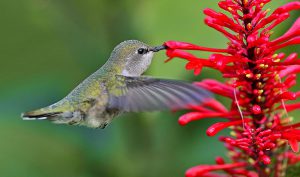 Looking to add something to brighten your landscape this autumn? Firespike (Odontonema strictum) is a prolific fall bloomer with red tubular flowers that are very popular with hummingbirds and butterflies. It’s glossy dark green leaves make an attractive large plant that will grow quite well in dense shade to partial sunlight. In frost-free areas firespike grows as an evergreen semi-woody shrub, spreads by underground sprouts and enlarging to form a thicket. In zones 8 and 9 it usually dies back to the ground in winter and resprouts in spring, producing strikingly beautiful 9-12 inch panicles of crimson flowers beginning at the end of summer and lasting into the winter each year. Firespike is native to open, semi-forested areas of Central America. It has escaped cultivation and become established in disturbed hammocks throughout peninsular Florida, but hasn’t presented an invasive problem. Here in the P
Looking to add something to brighten your landscape this autumn? Firespike (Odontonema strictum) is a prolific fall bloomer with red tubular flowers that are very popular with hummingbirds and butterflies. It’s glossy dark green leaves make an attractive large plant that will grow quite well in dense shade to partial sunlight. In frost-free areas firespike grows as an evergreen semi-woody shrub, spreads by underground sprouts and enlarging to form a thicket. In zones 8 and 9 it usually dies back to the ground in winter and resprouts in spring, producing strikingly beautiful 9-12 inch panicles of crimson flowers beginning at the end of summer and lasting into the winter each year. Firespike is native to open, semi-forested areas of Central America. It has escaped cultivation and become established in disturbed hammocks throughout peninsular Florida, but hasn’t presented an invasive problem. Here in the P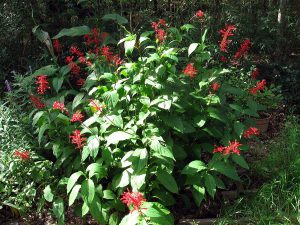 anhandle, firespike will remain a tender perennial for most locations. It can be grown on a wide range of moderately fertile, sandy soils and is quite drought tolerant. Firespike may be best utilized in the landscape in a mass planting. Plants can be spaced about 2 feet apart to fill in the area quickly. It is one of only a few flowering plants that give good, red color in a partially shaded site. The lovely flowers make firespike an excellent candidate for the cutting garden and is a “must-have” for southern butterfly and hummingbird gardens. Additional plants can be propagated from firespike by division or cuttings. However, white-tailed deer love firespike too, and will eat the leaves, so be prepared to fence it off from “Bambi”.
anhandle, firespike will remain a tender perennial for most locations. It can be grown on a wide range of moderately fertile, sandy soils and is quite drought tolerant. Firespike may be best utilized in the landscape in a mass planting. Plants can be spaced about 2 feet apart to fill in the area quickly. It is one of only a few flowering plants that give good, red color in a partially shaded site. The lovely flowers make firespike an excellent candidate for the cutting garden and is a “must-have” for southern butterfly and hummingbird gardens. Additional plants can be propagated from firespike by division or cuttings. However, white-tailed deer love firespike too, and will eat the leaves, so be prepared to fence it off from “Bambi”.
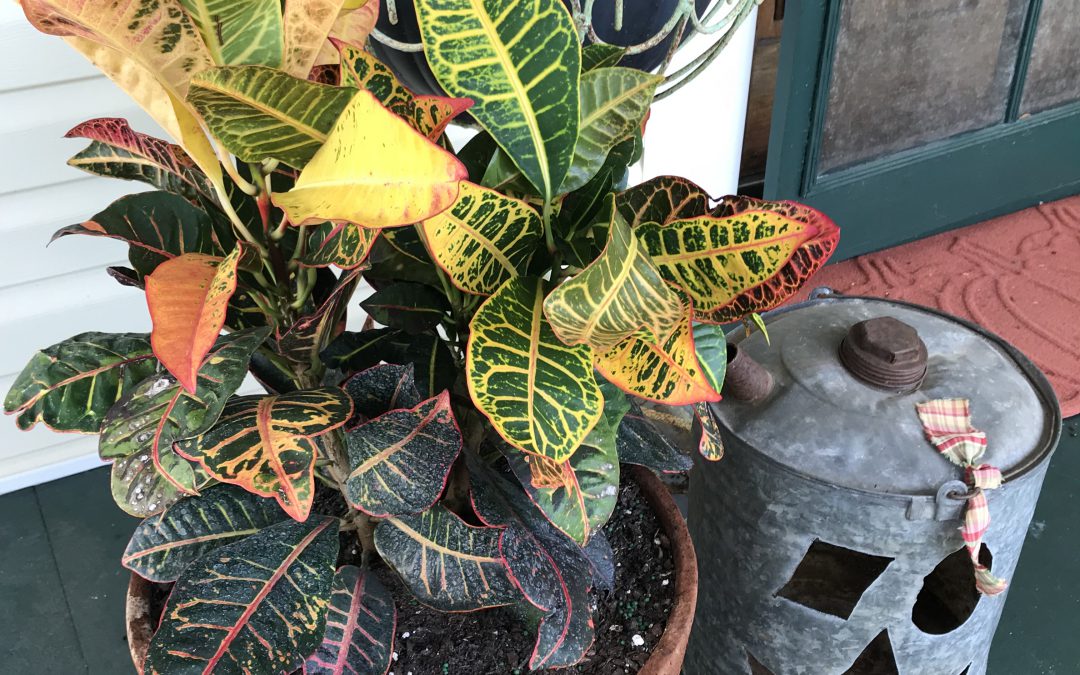
by Daniel J. Leonard | Sep 25, 2018
Florida is known for many things, however sweeping vistas of hillsides covered in the orange, red, and yellow foliage of fall is not one of them. Our long, hot summers and short, cool (not cold) winters, and lack of anything of substance resembling a season in between, precludes the fall color show our neighbors to the north enjoy. Don’t settle for synthetic Halloween decorations or faux painted leaves to add festivity to the autumn landscape design. When football season kicks off and summer blooming annuals begin to fade, it’s time to reach into the horticultural toolbox and pull out a couple fall-y Florida Friendly annual foliage species, perfect for the balmy Panhandle “autumn”: ‘Alabama Sunset’ coleus and ‘Petra’ croton.
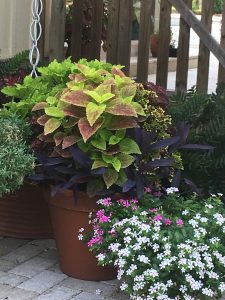
‘Alabama Sunset’ Coleus in mixed container – Photo Courtesy Andrea Schnapp
The first plant to consider when looking for outstanding heat tolerant foliage is the common coleus (Solenostemon scuttellarioides), particularly the cultivar ‘Alabama Sunset’. As the name indicates, ‘Alabama Sunset’ offers leaves in shades of red and yellow, perfect for designing fall containers or mixing into planting beds. This popular summer annual is known for its ability to add interesting color and texture to shady areas.
Recently with the arrival of the ‘sun coleus’ series (to which ‘Alabama Sunset’ belongs), coleus is permissible in situations with greater sunlight. Coleus is incredibly easy to grow and easy to find since nearly every nursery stocks at least a few cultivars. What’s more, these plants are generally free of pests and disease problems! Even sun coleus does appreciate a little protection from the hot afternoon sun and occasional deadheading of flowers.
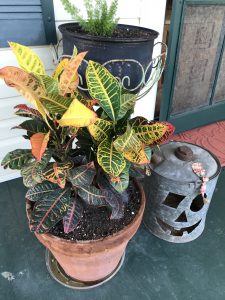
‘Petra’ Croton. Photo courtesy Daniel Leonard.
The second plant in the fall foliage arsenal is ‘Petra croton’ (Codiaeum variegatum ‘Petra’). Primarily known as a tropical foliage or indoor houseplant, Petra croton is criminally underused in fall landscape and container design. Petra croton sports bold magnolia-sized leaves striped with colors of yellow, red, orange, and black. A great Halloween plant to complement those front-porch Jack-O-Lanterns!
Like coleus, Petra croton is extremely easy to grow either in a container or in the ground. It should be located in either in full sun or partial shade and watered through establishment. Otherwise, this species is quite drought tolerant and can be killed with kindness if watered too frequently!
Although croton is a perennial shrub in the tropics, in Northwest Florida it may be killed by frost and best treated as an annual. Croton can be expected to reach 30-36” in height in a single season, its size and the boldly colored foliage make it a true focal point in the autumn landscape!
Appalachian-grade fall color may be unattainable in the Panhandle in the literal sense, but with these novel plant selections the autumn mood may be present even as the emerald waves hit the sugar white sand. By using annual foliage plants that possess traditional fall colors throughout their life cycle, anyone can add a splash of Autumn to their mixed containers or landscape beds. ‘Alabama Sunset’ coleus and ‘Petra’ croton are the perfect match for this time of year, pairing ease of culture with bold, seasonal color. Plant a couple today!

by Matt Lollar | Sep 6, 2018
A few months ago I visited a property that had been renovated to clean up some limbs that were in danger of falling on the house. Pruning tree limbs that are in danger of hitting a structure is always a good idea, but it’s important to look at the impacts this practice may have on the rest of a landscape. Any time the light profile of a landscape is changed, current and future plant selection must be considered. One often seen example occurs when trees grow to full size and shade out the lush lawn that’s underneath. However, in this case, removal of limbs allowed more light to shine on some beautiful, old camellia bushes.
Camellia Planting and Care
Camellias do best in locations that receive filtered sunlight and are protected from the wind. They like acidic, well-drained soils. Trees and shrubs are generally planted 2″ to 3″ above the soil grade. (2″ to 3″ of root ball should be exposed above the soil grade when the tree/shrub is planted.) To help improve root oxygen exposure and help prevent a root rot situations, camellias can be planted slightly shallower than the previously stated recommendation. For more plant establishment guidelines, please visit: UF/IFAS Planting and Establishing Trees Guide
Scenario and Diagnosis
As mentioned above, the property in question was visited to diagnose sick camellia bushes. Upon further inspection of the property, asking about recent changes to the landscape, and inspecting the bushes, it was clear that the camellias were receiving too much sunlight. Sunlight damage was expressed by large brown sunscald spots on the yellowing leaves.

Sunscald damage on camellia leaves. Photo Credit: Jed Dillard
The camellias had also been pruned incorrectly. Camellias require minimal pruning. They are normally pruned to control size or promote a tree form structure if desired. Any pruning should be done before flower buds form in late summer.

An incorrectly pruned camellia bush. Photo Credit: Jed Dillard
Solution
The best solution in this scenario was to dig up the affected camellias and move them to a location with more shade. Sun loving shrubs were suggested as options to replace the camellia bushes. It’s important to note that Camellia sasanqua cultivars are usually more tolerant of sunlight than Camellia japonica cultivars. The recommendations were based on the Florida Friendly Landscaping principle of “Right Plant, Right Place”.
If you’re trying to find the right plants for you own yard, then you should check out the Florida Friendly Landscaping Interactive Plant Database. The database gives you plant selection options for each area of your yard based on location in the state, plant type, and soil and light conditions.
















